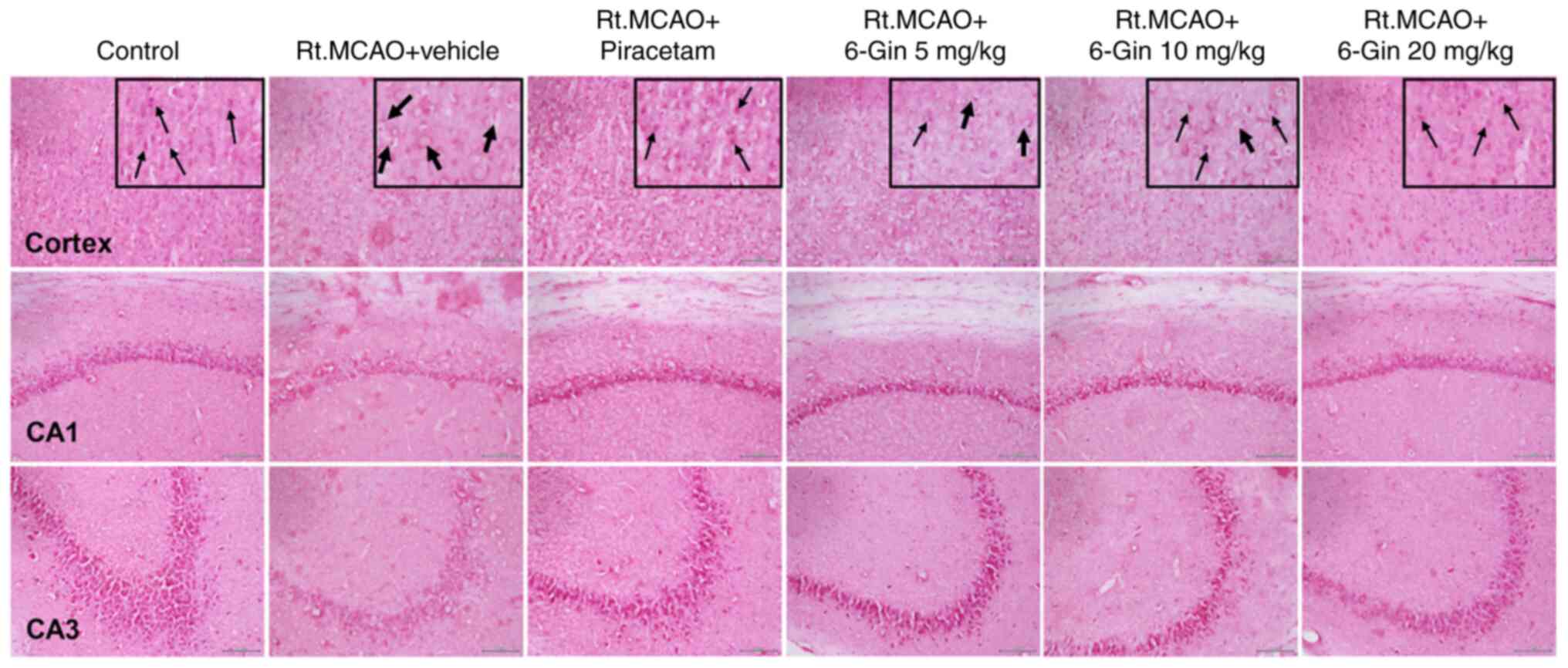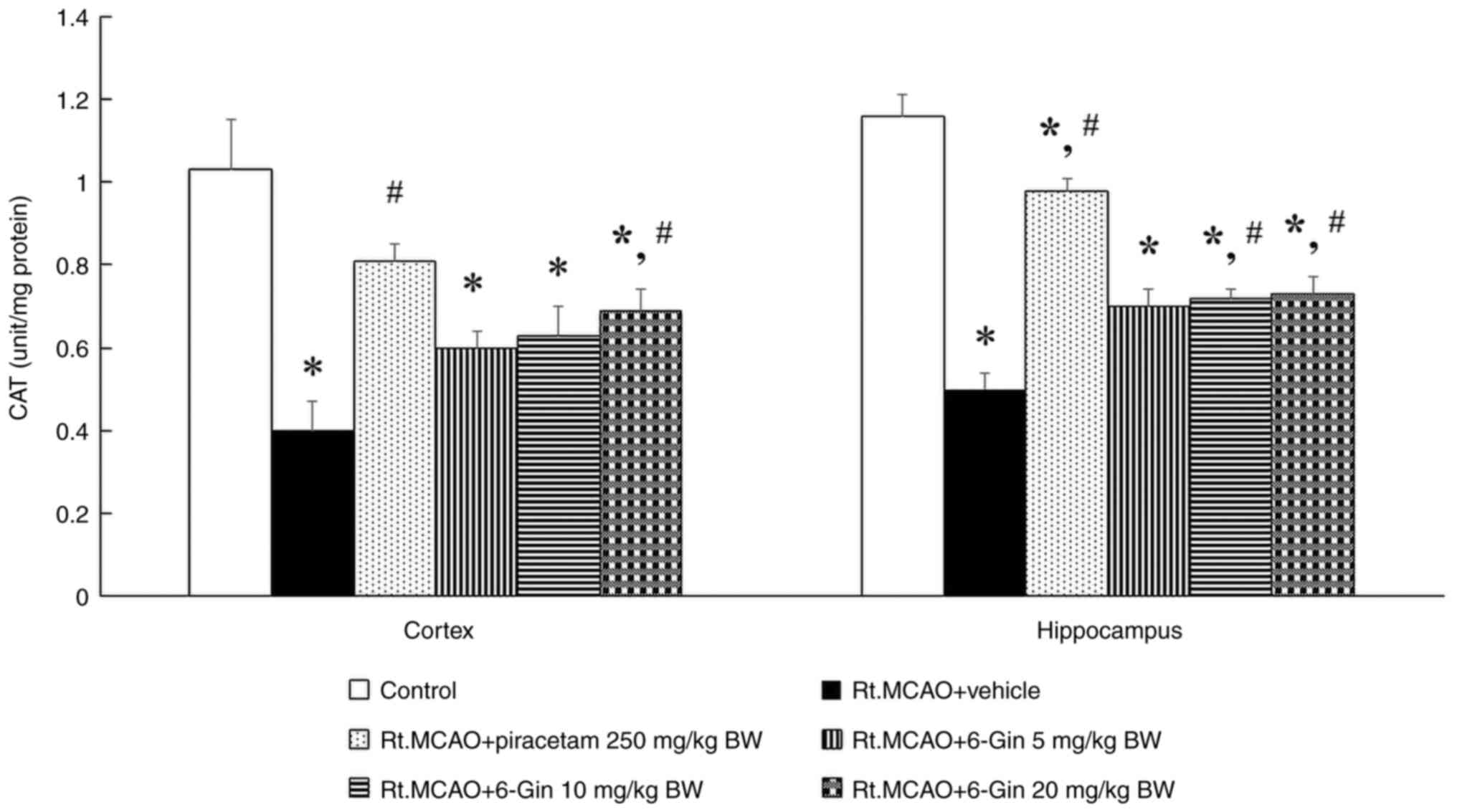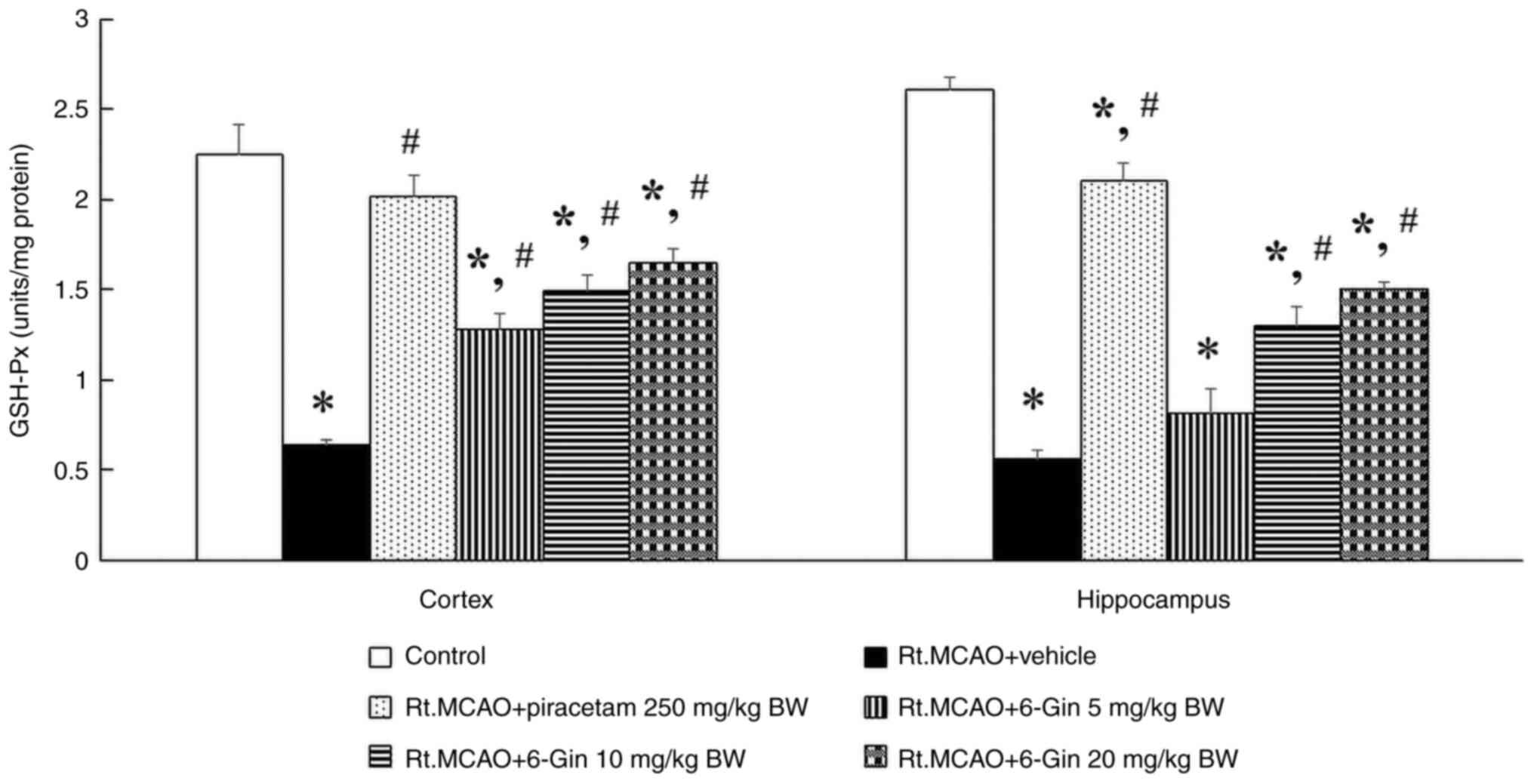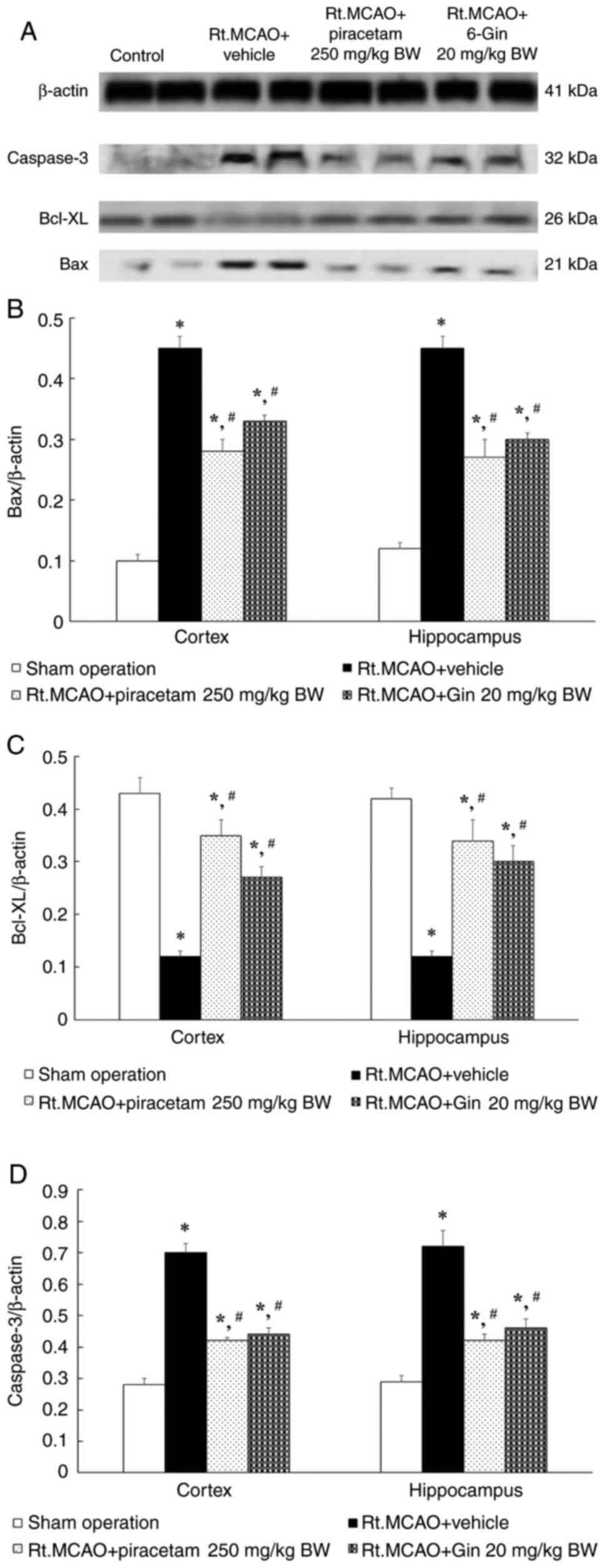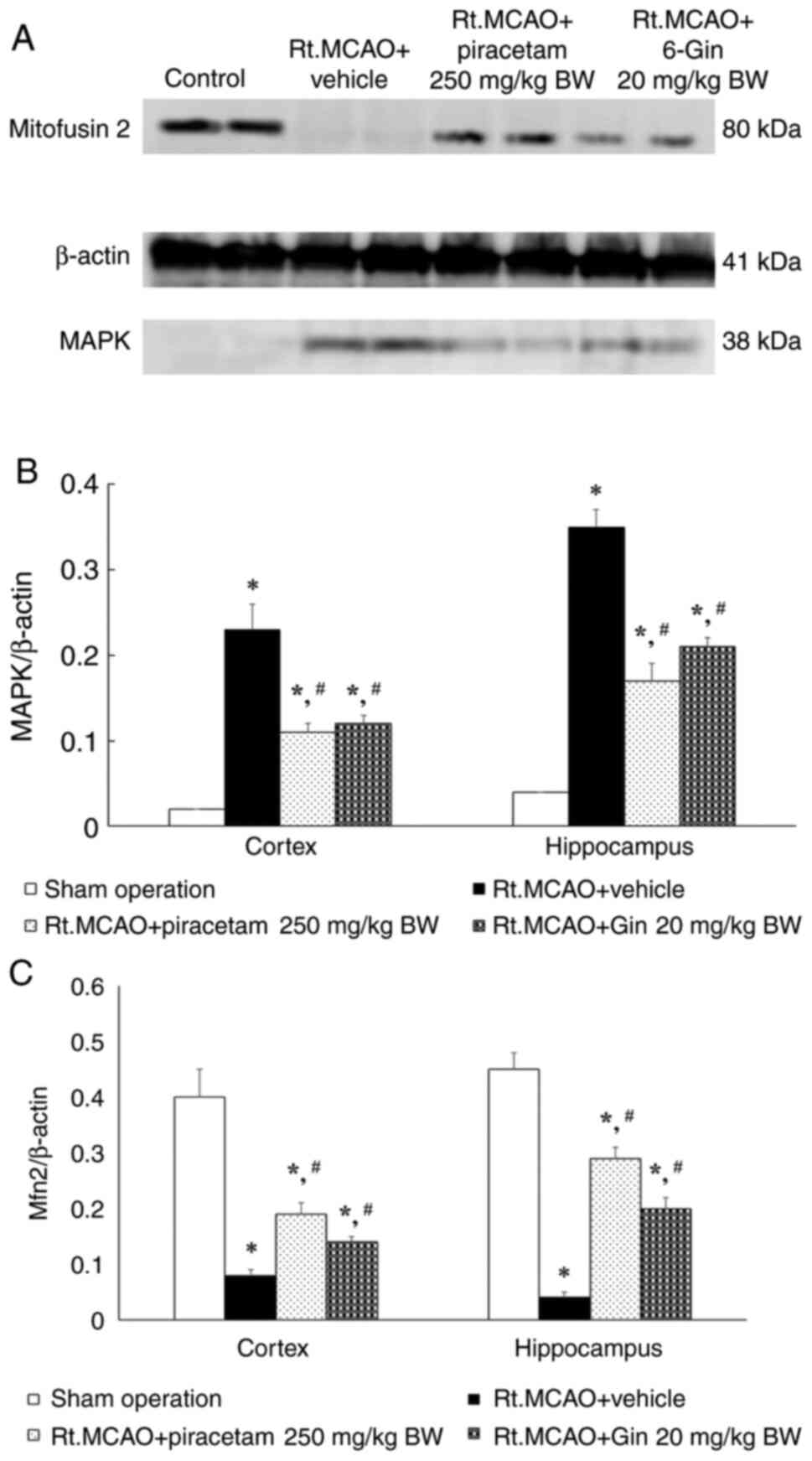|
1
|
Samuthpongtorn C, Jereerat T and Suwanwela
NC: Stroke risk factors, subtypes and outcome in elderly Thai
patients. BMC Neurol. 21(322)2021.PubMed/NCBI View Article : Google Scholar
|
|
2
|
Gebreyohannes EA, Bhagavathula AS, Abebe
TB, Seid MA and Haile KT: In-hospital mortality among ischemic
stroke patients in Gondar University Hospital: A retrospective
cohort study. Stroke Res Treat. 2019(7275063)2019.PubMed/NCBI View Article : Google Scholar
|
|
3
|
Lucas-Noll J, Clua-Espuny JL,
Lleixa-Fortuno M, Gavaldà-Espelta E, Queralt-Tomas L,
Panisello-Tafalla A and Carles-Lavila M: The costs associated with
stroke care continuum: A systematic review. Health Econ Rev.
13(32)2023.PubMed/NCBI View Article : Google Scholar
|
|
4
|
Checa J and Aran JM: Reactive Oxygen
Species: Drivers of Physiological and Pathological Processes. J
Inflamm Res. 13:1057–1073. 2020.PubMed/NCBI View Article : Google Scholar
|
|
5
|
Zivancevic K, Lovic D, Andjus PR and
Radenovic L: Neuroinflammation in Post-Ischemic Brain. In: Cerebral
Ischemia. Pluta R (ed). Brisbane, AU, 2021.
|
|
6
|
Chen L, Deng H, Cui H, Fang J, Zuo Z, Deng
J, Li Y, Wang X and Zhao L: Inflammatory responses and
inflammation-associated diseases in organs. Oncotarget.
9:7204–7218. 2017.PubMed/NCBI View Article : Google Scholar
|
|
7
|
Wu L, Xiong X, Wu X, Ye Y, Jian Z, Zhi Z
and Gu L: Targeting oxidative stress and inflammation to prevent
ischemia-reperfusion injury. Front Mol Neurosci.
13(28)2020.PubMed/NCBI View Article : Google Scholar
|
|
8
|
Qin C, Yang S, Chu YH, Zhang H, Pang XW,
Chen L, Zhou LQ, Chen M, Tian DS and Wang W: Signaling pathways
involved in ischemic stroke: Molecular mechanisms and therapeutic
interventions. Signal Transduct Target Ther. 7(215)2022.PubMed/NCBI View Article : Google Scholar
|
|
9
|
Mao R, Zong N, Hu Y, Chen Y and Xu Y:
Neuronal death mechanisms and therapeutic strategy in ischemic
stroke. Neurosci Bull. 38:1229–1247. 2022.PubMed/NCBI View Article : Google Scholar
|
|
10
|
Otsuka S, Itashiki Y, Tani A, Matsuoka T,
Takada S, Matsuzaki R, Nakanishi K, Norimatsu K, Tachibe Y,
Kitazato R, et al: Effects of different remote ischemia
perconditioning methods on cerebral infarct volume and neurological
impairment in rats. Sci Rep. 13(2158)2023.PubMed/NCBI View Article : Google Scholar
|
|
11
|
Sun Y, Xu Y and Geng L: Caspase-3
inhibitor prevents the apoptosis of brain tissue in rats with acute
cerebral infarction. Exp Ther Med. 10:133–138. 2015.PubMed/NCBI View Article : Google Scholar
|
|
12
|
Park HA, Broman K and Jonas EA: Oxidative
stress battles neuronal Bcl-xL in a fight to the death. Neural
Regen Res. 16:12–15. 2021.PubMed/NCBI View Article : Google Scholar
|
|
13
|
Gao ZK, Shen XY, Han Y, Guo YS, Li K and
Bi X: Pre-ischemic exercise prevents inflammation and apoptosis by
inhibiting MAPK pathway in ischemic stroke. Transl Neurosci.
13:495–505. 2022.PubMed/NCBI View Article : Google Scholar
|
|
14
|
Zhu Z, Ge M, Li C, Yu L, Gu Y, Hu Y and
Cao Z: Effects of p38 MAPK signaling pathway on cognitive function
and recovery of neuronal function after hypoxic-ischemic brain
injury in newborn rats. J Clin Neurosci. 78:365–370.
2020.PubMed/NCBI View Article : Google Scholar
|
|
15
|
Hou K, Xiao ZC and Dai HL: p38 MAPK
Endogenous inhibition improves neurological deficits in global
cerebral ischemia/reperfusion mice. Neural Plast.
2022(3300327)2022.PubMed/NCBI View Article : Google Scholar
|
|
16
|
Vongsfak J, Pratchayasakul W, Apaijai N,
Vaniyapong T, Chattipakorn N and Chattipakorn SC: The alterations
in mitochondrial dynamics following cerebral ischemia/reperfusion
injury. Antioxidants (Basel). 10(1384)2021.PubMed/NCBI View Article : Google Scholar
|
|
17
|
Li J, Wu J, Zhou X, Lu Y, Ge Y and Zhang
X: Targeting neuronal mitophagy in ischemic stroke: An update.
Burns Trauma. 11(tkad018)2023.PubMed/NCBI View Article : Google Scholar
|
|
18
|
Li C, Chen C, Qin H, Ao C, Chen J, Tan J
and Zeng L: The role of mitochondrial dynamin in stroke. Oxid Med
Cell Longev. 2022(2504798)2022.PubMed/NCBI View Article : Google Scholar
|
|
19
|
Kongsui R and Jittiwat J: Ameliorative
effects of 6-gingerol in cerebral ischemia are mediated via the
activation of antioxidant and anti-inflammatory pathways. Biomed
Rep. 18(26)2023.PubMed/NCBI View Article : Google Scholar
|
|
20
|
Almatroodi SA, Alnuqaydan AM, Babiker AY,
Almogbel MA, Khan AA and Husain Rahmani A: 6-Gingerol, a bioactive
compound of ginger attenuates renal damage in
streptozotocin-induced diabetic rats by regulating the oxidative
stress and inflammation. Pharmaceutics. 13(317)2021.PubMed/NCBI View Article : Google Scholar
|
|
21
|
Wang S, Zhang C, Yang G and Yang Y:
Biological properties of 6-gingerol: A brief review. Nat Prod
Commun. 9:1027–1030. 2014.PubMed/NCBI
|
|
22
|
Mao QQ, Xu XY, Cao SY, Gan RY, Corke H,
Beta T and Li HB: Bioactive compounds and bioactivities of ginger
(Zingiber officinale Roscoe). Foods. 8(185)2019.PubMed/NCBI View Article : Google Scholar
|
|
23
|
Jittiwat J, Suksamrarn A, Tocharus C and
Tocharus J: Dihydrocapsaicin effectively mitigates cerebral
ischemia-induced pathological changes in vivo, partly via
antioxidant and anti-apoptotic pathways. Life Sci.
283(119842)2021.PubMed/NCBI View Article : Google Scholar
|
|
24
|
Adetuyi BO and Farombi EO: 6-Gingerol, an
active constituent of ginger, attenuates lipopolysaccharide-induced
oxidation, inflammation, cognitive deficits, neuroplasticity, and
amyloidogenesis in rat. J Food Biochem. 45(e13660)2021.PubMed/NCBI View Article : Google Scholar
|
|
25
|
Jittiwat J: Baihui point laser acupuncture
ameliorates cognitive impairment, motor deficit, and neuronal loss
partly via antioxidant and anti-inflammatory effects in an animal
model of focal ischemic stroke. Evid Based Complement Alternat Med.
2019(1204709)2019.PubMed/NCBI View Article : Google Scholar
|
|
26
|
Lowry OH, Rosebrough NJ, Farr AL and
Randall RJ: Protein measurement with the Folin phenol reagent. J
Biol Chem. 193:265–275. 1951.PubMed/NCBI
|
|
27
|
Goldblith SA and Proctor BE: Photometric
determination of catalase activity. J Biol Chem. 187:705–709.
1950.PubMed/NCBI
|
|
28
|
Davis SM and Pennypacker KR: Targeting
antioxidant enzyme expression as a therapeutic strategy for
ischemic stroke. Neurochem Int. 107:23–32. 2017.PubMed/NCBI View Article : Google Scholar
|
|
29
|
Alharbi KS, Nadeem MS, Afzal O, Alzarea
SI, Altamimi ASA, Almalki WH, Mubeen B, Iftikhar S, Shah L and
Kazmi I: Gingerol, a natural antioxidant, attenuates hyperglycemia
and downstream complications. Metabolites. 2(1274)2022.PubMed/NCBI View Article : Google Scholar
|
|
30
|
Ajayi BO, Adedara IA and Farombi EO:
Protective mechanisms of 6-gingerol in dextran sulfate
sodium-induced chronic ulcerative colitis in mice. Hum Exp Toxicol.
37:1054–1068. 2018.PubMed/NCBI View Article : Google Scholar
|
|
31
|
Ozkur M, Benlier N, Takan I, Vasileiou C,
Georgakilas AG, Pavlopoulou A, Cetin Z and Saygili EI: Ginger for
healthy ageing: A systematic review on current evidence of its
antioxidant, anti-inflammatory, and anticancer properties. Oxid Med
Cell Longev. 2022(4748447)2022.PubMed/NCBI View Article : Google Scholar
|
|
32
|
Abolaji AO, Ojo M, Afolabi TT, Arowoogun
MD, Nwawolor D and Farombi EO: Protective properties of
6-gingerol-rich fraction from Zingiber officinale (Ginger)
on chlorpyrifos-induced oxidative damage and inflammation in the
brain, ovary and uterus of rats. Chem Biol Interact. 270:15–23.
2017.PubMed/NCBI View Article : Google Scholar
|
|
33
|
Bas J, Nguyen T and Gillet G: Involvement
of Bcl-xL in neuronal function and development. Int J Mol Sci.
22(3202)2021.PubMed/NCBI View Article : Google Scholar
|
|
34
|
Broughton BR, Reutens DC and Sobey CG:
Apoptotic mechanisms after cerebral ischemia. Stroke. 40:e331–339.
2009.PubMed/NCBI View Article : Google Scholar
|
|
35
|
Glushakova OY, Glushakov AA, Wijesinghe
DS, Valadka AB, Hayes RL and Glushakov AV: Prospective clinical
biomarkers of caspase-mediated apoptosis associated with neuronal
and neurovascular damage following stroke and other severe brain
injuries: Implications for chronic neurodegeneration. Brain Circ.
3:87–108. 2017.PubMed/NCBI View Article : Google Scholar
|
|
36
|
Bagheri G, Rezaee R, Tsarouhas K, Docea
AO, Shahraki J, Shahriari M, Wilks MF, Jahantigh H, Tabrizian K,
Moghadam AA, et al: Magnesium sulfate ameliorates carbon
monoxide-induced cerebral injury in male rats. Mol Med Rep.
19:1032–1039. 2019.PubMed/NCBI View Article : Google Scholar
|
|
37
|
Liu G, Wang T, Wang T, Song J and Zhou Z:
Effects of apoptosis-related proteins caspase-3, Bax and Bcl-2 on
cerebral ischemia rats. Biomed Rep. 1:861–867. 2013.PubMed/NCBI View Article : Google Scholar
|
|
38
|
Gupta R and Ghosh S: Putative roles of
mitochondrial Voltage-Dependent Anion Channel, Bcl-2 family
proteins and c-Jun N-terminal Kinases in ischemic stroke associated
apoptosis. Biochim Open. 4:47–55. 2017.PubMed/NCBI View Article : Google Scholar
|
|
39
|
Yenari MA: Pathophysiology of acute
ischemic stroke. Cleve Clin J Med. 71 (Suppl 1):S25–S27.
2004.PubMed/NCBI View Article : Google Scholar
|
|
40
|
Shang JL, Cheng Q, Duan SJ, Li L and Jia
LY: Cognitive improvement following ischemia/reperfusion injury
induced by voluntary running-wheel exercise is associated with
LncMALAT1-mediated apoptosis inhibition. Int J Mol Med.
41:2715–2723. 2018.PubMed/NCBI View Article : Google Scholar
|
|
41
|
Li Z, Xiao G, Wang H, He S and Zhu Y: A
preparation of Ginkgo biloba L. leaves extract inhibits the
apoptosis of hippocampal neurons in post-stroke mice via regulating
the expression of Bax/Bcl-2 and Caspase-3. J Ethnopharmacol.
280(114481)2021.PubMed/NCBI View Article : Google Scholar
|
|
42
|
Zhai Y, Liu BG, Mo XN, Zou M, Mei XP, Chen
W, Huang GD and Wu L: Gingerol ameliorates neuronal damage induced
by hypoxia-reoxygenation via the miR-210/brain-derived neurotrophic
factor axis. Kaohsiung J Med Sci. 38:367–377. 2022.PubMed/NCBI View Article : Google Scholar
|
|
43
|
Alsahli MA, Almatroodi SA, Almatroudi A,
Khan AA, Anwar S, Almutary AG, Alrumaihi F and Rahmani AH:
6-Gingerol, a major ingredient of ginger attenuates
diethylnitrosamine-induced liver injury in rats through the
modulation of oxidative stress and anti-inflammatory activity.
Mediators Inflamm. 2021(6661937)2021.PubMed/NCBI View Article : Google Scholar
|
|
44
|
Luo J, Chen J, Yang C, Tan J, Zhao J,
Jiang N and Zhao Y: 6-Gingerol protects against cerebral
ischemia/reperfusion injury by inhibiting NLRP3 inflammasome and
apoptosis via TRPV1/FAF1 complex dissociation-mediated autophagy.
Int Immunopharmacol. 100(108146)2021.PubMed/NCBI View Article : Google Scholar
|
|
45
|
Verma DK, Gupta S, Biswas J, Joshi N,
Singh A, Gupta P, Tiwari S, Sivarama Raju K, Chaturvedi S,
Wahajuddin M and Singh S: New therapeutic activity of metabolic
enhancer piracetam in treatment of neurodegenerative disease:
Participation of caspase independent death factors, oxidative
stress, inflammatory responses and apoptosis. Biochim Biophys Acta
Mol Basis Dis. 1864:2078–2096. 2018.PubMed/NCBI View Article : Google Scholar
|
|
46
|
Mohammed AS, Al-Hassani AN, Alrawi RA and
Tawfeeq RD: The protective effect of taurine, piracetam and
vinpocetine on etoposide-induced inflammation and brain injury in
the serum of female albino rats. Ecancermedicalscience.
17(1499)2023.PubMed/NCBI View Article : Google Scholar
|
|
47
|
Tortiglione A, Minale M, Pignataro G,
Amoroso S, DiRenzo G and Annunziato L: The 2-oxopyrrolidinacetamide
piracetam reduces infarct brain volume induced by permanent middle
cerebral artery occlusion in male rats. Neuropharmacology.
43:427–433. 2002.PubMed/NCBI View Article : Google Scholar
|
|
48
|
Kessler J, Thiel A, Karbe H and Heiss WD:
Piracetam improves activated blood flow and facilitates
rehabilitation of poststroke aphasic patients. Stroke.
31:2112–2116. 2000.PubMed/NCBI View Article : Google Scholar
|
|
49
|
Yang Y, Feng J, Xu F and Wang J: Piracetam
inhibits ethanol (EtOH)-induced memory deficit by mediating
multiple pathways. Brain Res. 1676:83–90. 2017.PubMed/NCBI View Article : Google Scholar
|
|
50
|
Gugliandolo A, Silvestro S, Sindona C,
Bramanti P and Mazzon E: MiRNA: Involvement of the MAPK pathway in
ischemic stroke. A promising therapeutic target. Medicina (Kaunas).
57(1053)2021.PubMed/NCBI View Article : Google Scholar
|
|
51
|
Safa A, Abak A, Shoorei H, Taheri M and
Ghafouri-Fard S: MicroRNAs as regulators of ERK/MAPK pathway: A
comprehensive review. Biomed Pharmacother.
132(110853)2020.PubMed/NCBI View Article : Google Scholar
|
|
52
|
Zhang FL, Zhou BW, Yan ZZ, Zhao J, Zhao
BC, Liu WF, Li C and Liu KX: 6-Gingerol attenuates macrophages
pyroptosis via the inhibition of MAPK signaling pathways and
predicts a good prognosis in sepsis. Cytokine.
125(154854)2020.PubMed/NCBI View Article : Google Scholar
|
|
53
|
Kang C, Kang M, Han Y, Zhang T, Quan W and
Gao J: 6-Gingerols (6G) reduces hypoxia-induced PC-12 cells
apoptosis and autophagy through regulation of miR-103/BNIP3. Artif
Cells Nanomed Biotechnol. 47:1653–1661. 2019.PubMed/NCBI View Article : Google Scholar
|
|
54
|
Yang JL, Mukda S and Chen SD: Diverse
roles of mitochondria in ischemic stroke. Redox Biol. 16:263–275.
2018.PubMed/NCBI View Article : Google Scholar
|
|
55
|
Yang M, He Y, Deng S, Xiao L, Tian M, Xin
Y, Lu C, Zhao F and Gong Y: Mitochondrial quality control: A
pathophysiological mechanism and therapeutic target for stroke.
Front Mol Neurosci. 14(786099)2022.PubMed/NCBI View Article : Google Scholar
|
|
56
|
Martorell-Riera A, Segarra-Mondejar M,
Munoz JP, Ginet V, Olloquequi J, Pérez-Clausell J, Palacín M, Reina
M, Puyal J, Zorzano A and Soriano FX: Mfn2 downregulation in
excitotoxicity causes mitochondrial dysfunction and delayed
neuronal death. EMBO J. 33:2388–2407. 2014.PubMed/NCBI View Article : Google Scholar
|
|
57
|
Jurcau A and Ardelean AI: Oxidative stress
in ischemia/reperfusion injuries following acute ischemic stroke.
Biomedicines. 10(574)2022.PubMed/NCBI View Article : Google Scholar
|
|
58
|
Wang R, Santos JM, Dufour JM, Stephens ER,
Miranda JM, Washburn RL, Hibler T, Kaur G, Lin D and Shen CL:
Ginger root extract improves GI health in diabetic rats by
improving intestinal integrity and mitochondrial function.
Nutrients. 14(4384)2022.PubMed/NCBI View Article : Google Scholar
|
|
59
|
Razak AM, Tan JK, Mohd Said M and Makpol
S: Modulating effects of zingiberaceae phenolic compounds on
neurotrophic factors and their potential as neuroprotectants in
brain disorders and age-associated neurodegenerative disorders: A
review. Nutrients. 15(2564)2023.PubMed/NCBI View Article : Google Scholar
|
|
60
|
Kelava T, Javar I and Culo F: Biological
actions of drug solvents. Periodicum Biologorum. 113:311–320.
2011.
|
|
61
|
Kurdi SJA, Hamid NFS, Ranneh Y, Meng GY
and Hashim ZB: Dimethyl Sulfoxide and Their Toxicity. Int J Res
Biol Pharm. 5:9–18. 2019.
|
|
62
|
Kloverpris H, Fomsgaard A, Handley A,
Ackland J, Sullivan M and Goulder P: Dimethyl sulfoxide (DMSO)
exposure to human peripheral blood mononuclear cells (PBMCs)
abolish T cell responses only in high concentrations and following
coincubation for more than two hours. J Immunol Methods. 356:70–78.
2010.PubMed/NCBI View Article : Google Scholar
|
|
63
|
Janyou A, Wicha P, Jittiwat J, Suksamrarn
A, Tocharus C and Tocharus J: Dihydrocapsaicin attenuates blood
brain barrier and cerebral damage in focal cerebral
ischemia/reperfusion via oxidative stress and inflammatory. Sci
Rep. 7(10556)2017.PubMed/NCBI View Article : Google Scholar
|
|
64
|
Xu S, Lu J, Shao A, Zhang JH and Zhang J:
Glial cells: Role of the immune response in ischemic stroke. Front
Immunol. 11(294)2020.PubMed/NCBI View Article : Google Scholar
|
|
65
|
Amantea D, Micieli G, Tassorelli C,
Cuartero MI, Ballesteros I, Certo M, Moro MA, Lizasoain I and
Bagetta G: Rational modulation of the innate immune system for
neuroprotection in ischemic stroke. Front Neurosci.
9(147)2015.PubMed/NCBI View Article : Google Scholar
|



